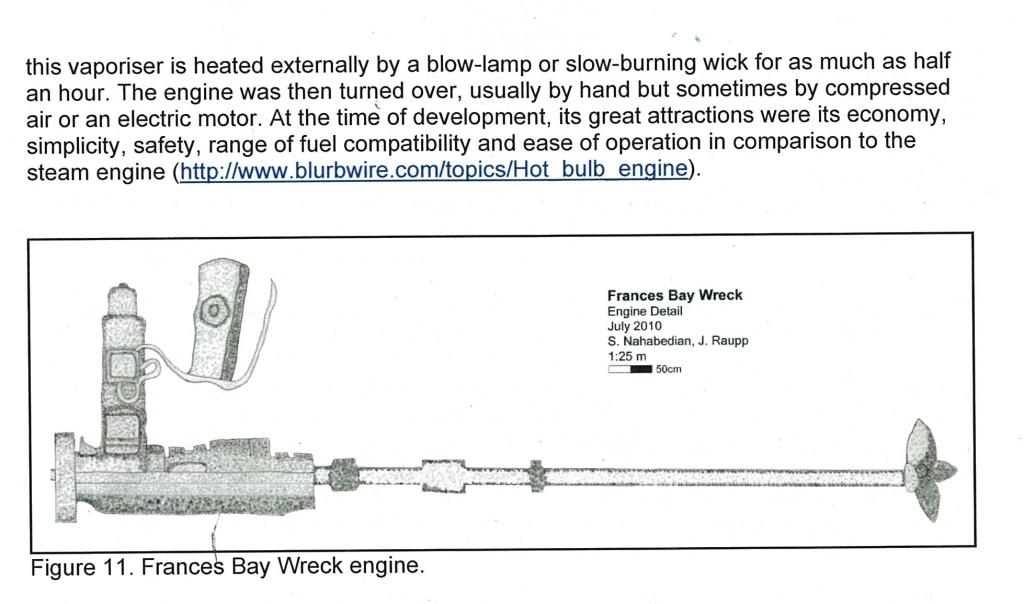|
| Identify wreck based on hot bulb engine |
| Author |
Message |
    
David Steinberg
New member
Username: heritage_branch
Post Number: 1
Registered: 03-2011
| | Posted on Sunday, March 27, 2011 - 10:23 pm: | 




|
Dear group, I am a maritime archaeologist for the Northern Territory Government in Australia and we are trying to identify a shipwreck based on its engine. I have attached a sketch of the engine done by divers. We believe it is a single cylinder hot bulb oil engine (I can also send a DVD of underwater footage to assist an individual who knows this type well). Based on other site features we think it may be the Huddersfield, but the Lloyds entry tells us this ship had a two cylinder engine (see attachment). Can experts take a look at the underwater sketch and the Huddersfield engine type and let me know if these can match in any way. Also does anyone have a design sketch of what the engine on the Huddersfield would have looked like based on the Lloyds entry? Thanks so much for your time. I was very glad to have stumbled on this excellent discussion board. cheers David  |
    
Mark S
Senior Member
Username: marks
Post Number: 136
Registered: 03-2002
| | Posted on Tuesday, March 29, 2011 - 03:05 am: | 




|
Hello David,
A few observations and questions if I may.
1) The sketch to me shows a single cylinder engine of a "hot bulb" or "semi diesel" type. The Llyods entry for the Huddersfield has a twin cylinder of 28NHP which would be quite a large engine physically. From the sketch and the scale the cylinder appears to be 3-4m in height.
2) In terms of it being a single cylinder could the other cylinder shaped piece at the end of the "seaweed" type thing be the second cylinder. The sketch indicates that there may be a "spot" for it just in front of the gearbox?
3) Do you have any photos of the engine, perhaps some stills from the DVD as they would be most helpful in identifying the engine?
4) I will look through my paper collection, in particular the NSW section for a similar engine as it seems, from the Llyods register that the builder is J. Dent of Jervis Bay. Or perhaps I'm reading the register incorrectly
I would like to add that this is most interesting.
Best Regards,
Mark S. |
    
Andrew Munns
Member
Username: johnoxley
Post Number: 21
Registered: 04-2010
| | Posted on Tuesday, March 29, 2011 - 04:05 am: | 




|
Hi - A 13" piston means a sizeable engine - add 1.5" for the cylinder walls + 2" to 3" for the hollow water jacket spaces + 1" for the outer walls gives a total diameter of about 18".
Are there measurements of the engine and cylinders? The flywheel looks a bit small for a single cylinder engine... Is there mechanical damage from trawlers? Could the engine have been partially dismantled when the vessel sank? An auxiliary sailing vessel in those days would not be relying on the engine much... What if you took a sample of structural timber and had it identified as a south coast hardwood?? Andym |
    
Mark S
Senior Member
Username: marks
Post Number: 137
Registered: 03-2002
| | Posted on Tuesday, March 29, 2011 - 06:29 am: | 




|
According to this newspaper article from the Cairns Post, 7th December 1928 the Huddersfield had a Scandinavian built engine.
Cheers,
Mark S.
 |
    
lloyd allan beeby
Member
Username: lloydsboats
Post Number: 4
Registered: 01-2008
| | Posted on Saturday, April 02, 2011 - 05:53 am: | 




|
the news paper article writes that the vessel was built by J Dent in jervis bay there was a maritime museum at at jervis bay, maybe still is it had a lot of information from the dents and family boatbuilding history they continued to build fishing trawlers up to the 1970s it may have some information that you require |
    
David Steinberg
New member
Username: heritage_branch
Post Number: 2
Registered: 03-2011
| | Posted on Monday, April 11, 2011 - 12:01 am: | 




|
Thanks everyone for your replies, and I apologise for the delay in my response. Mark and Andrew you both raised important questions about the size of the wreck's engine in comparison to the Huddersfield’s details. Some wreck engine dimensions were measured on the field trip, as follows: flywheel (105cm diameter and 25cm thick), engine cylinder (150cm tall and 50cm in diameter), with a cylinder head (35cm tall and 35cm wide), the engine block measures approximately 3mtr long. Based on these dimensions I'm assuming the wreck engine could have accommodated the Huddersfield cylinder size. Can I ask: based on the above dimensions of cylinder and flywheel what class of engine is this in terms of horse power? The Huddersfield was 23 NHP. Another possibility, a smaller vessel had a 15 horse power engine. Mark, regarding the possibility of a cylinder broken away, and this actually being a 2 cylinder engine, somebody else who knows these engines watched the video and thought the same. Mark my email is [email protected] if you want to make contact and view a DVD of the engine. Looking forward to anymore help you can provide.
thanks
david |
|
|
|


|


